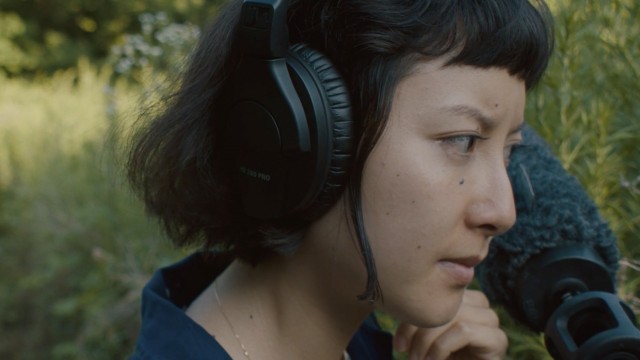If you’re one of the many people who has, or still is, falling victim to imposter syndrome, then today’s film pick – Invasive Species by Annie Ning – is one that is bound to resonate strongly. The story of a young artist (Maggie) attending her first residency, this immersive short employs the enclosed nature of its location and the specifics of its protagonist’s practice, as a sound artist, to trap us in her headspace.
Introducing us to Maggie, and the space she finds herself in for her first ever residency, as she listens to a talk about “communal living values”, Ning’s short instantly provides an impression of the gathering she’s attending, without revealing anything (yet) of its central character. In the next scene, at one of the community’s round table meals, we start to get a sense of her situation, as she listens to the conversation grow around her, without ever really getting involved.
As the attention of her neighbouring diners turns to Maggie’s art, we witness her struggling to explain her focus and we’re introduced to the other main character of Invasive Species – Maggie’s imposter syndrome. From this point, Ning amplifies the isolated position of her central character in this space through the moments she spends apart from the group, with Anthony Sertel Dean’s sound design playing an important role.

Emily May Jampel as Maggie in Invasive Species
“Sound brings us into Maggie’s internal landscape”, Ning reveals in an interview for the film’s online release as a Vimeo Staff Pick Premiere. With the director explaining how she wanted her protagonist to begin as “an almost impenetrable and passive observer”, the sound design of the short offers the audience a “way for us to access her feelings and punctuate the off-kilter world she experiences around her”.
Inspired by Ning’s own experiences with the condition, Invasive Species presents an effective and relatable portrayal of imposter syndrome, one where the director hoped to capture the “funny, ridiculous and also hideous parts” of those feelings. As someone who has experienced bouts of imposter syndrome throughout my adult life, witnessing its symptoms depicted creatively is captivating, and this short film serves as a reminder to others facing similar struggles that they are not alone in having these thoughts. Equally vital in the film’s success is just how entertaining it is, with the short culminating in a conclusion that offers a gratifying resolution for all viewers, regardless of their ability to relate to Maggie’s journey.

 Rob Munday
Rob Munday